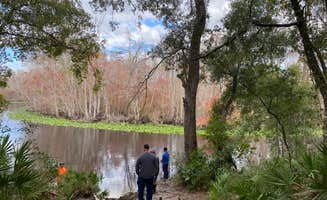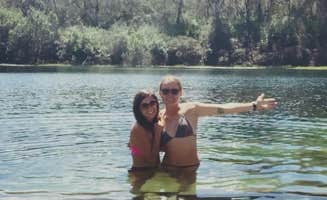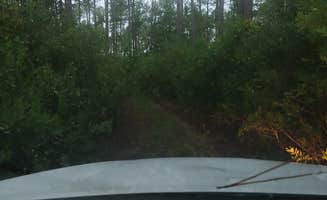Dispersed camping opportunities near Bunnell, Florida extend across sections of the Ocala National Forest, situated in central Florida's sand pine scrub ecosystem. Elevations throughout the forest rarely exceed 100 feet above sea level, creating primarily flat terrain with occasional shallow ravines around water features. These primitive sites function under standard U.S. Forest Service regulations with seasonal considerations including higher humidity from late spring through early fall and frequent afternoon thunderstorms during summer months.
What to do
Water activities: St. Johns River Dispersed Spot provides direct river access for fishing, swimming, and stargazing. "Right next to the river and the trees open up so you get a great view of the stars," notes camper Mike D., who adds that "the roads to get here are bumpy" but the location rewards those who make the effort.
Wildlife observation: The forest contains diverse wildlife habitats for species including deer, turkey, and numerous bird species. Watch for tracks along sandy trails and near water sources, particularly during early morning and evening hours when animals are most active. At Davenport Landing, one visitor mentioned, "We didn't see anything bad with this place when we were there. Had no one around and nice and cool in the forest."
Hiking trails: Several primitive trails connect camping areas to historic sites and natural features. The 1.2-mile interpretive Davenport Landing Trail leads to a former steamboat landing with historical significance. Multiple unmaintained user trails branch from main camping areas throughout the forest, requiring basic navigation skills and awareness of surroundings.
What campers like
Solitude and quiet: Many sites receive minimal visitation, especially during weekdays and non-hunting seasons. One camper at Trout Lake Primitive Sites described the experience as "nice secluded sites" with "set of primitive spots near lake," highlighting the privacy available to those willing to navigate the access challenges.
Natural swimming spots: Several camping areas feature access to natural water features with swimming opportunities. Blue Sink was described by camper Destiny R. as the "Most beautiful place to stumble upon. You may need ATV or creative backpacking to get there now. The Forestry Service recently chopped down trees and covered the easy access roads."
Cost-free camping: Most dispersed sites in the Ocala National Forest offer free camping near Bunnell, Florida without reservation requirements. This allows flexibility for last-minute trips and extended stays, though campers must adhere to standard 14-day stay limits. "Primitive, no reservations, gets some traffic visiting historic site," noted one visitor about the camping experience.
What you should know
Vehicle requirements: Forest roads accessing many sites deteriorate significantly after rain. Standard passenger vehicles risk becoming stuck or damaged on several routes. At Freak Creek Dispersed Camping, camper hilary G. warns, "If you don't have 4wd and recovery gear I wouldn't risk it. There is a nice creek area where you can swim and or fish if you have the right equipment to get back there it can be fun, but if you don't you will be stuck until some one comes by."
Facility limitations: Dispersed sites lack all amenities including potable water, restrooms, garbage disposal, and designated fire rings. Campers must pack in all supplies and pack out all waste. Cell service ranges from poor to non-existent across most areas, requiring alternative communication methods for emergencies.
Site variability: Conditions at primitive camping areas change frequently based on weather, seasonal use patterns, and forest management activities. Sites that appear suitable on maps may prove inaccessible or unsuitable upon arrival. Always have backup location options identified before traveling to this area for no-fee camping near Bunnell.
Tips for camping with families
Safety planning: Establish clear boundaries for children around water features and forest exploration. Water bodies throughout the forest may contain alligators and other wildlife requiring appropriate caution. Prepare a specific emergency action plan including evacuation routes and nearest hospital locations before arrival.
Weather preparation: Florida's unpredictable weather patterns require flexible planning for family camping trips. Summer temperatures regularly exceed 90°F with high humidity, while afternoon thunderstorms occur frequently from June through September. One visitor mentioned camping was "nice and cool in the forest," highlighting how tree cover can moderate temperatures.
Wildlife precautions: Secure all food items in wildlife-resistant containers or vehicle storage. Several campers report signs of bears and other wildlife near campsites. When camping at Trout Lake, one camper noted the sites were "Not the cleanest but passable," suggesting families should inspect sites upon arrival and consider bringing cleaning supplies.
Tips from RVers
Vehicle dimensions: Forest roads access roads feature extremely tight clearances between trees, causing potential damage to vehicle exteriors. One visitor to Trout Lake noted, "Main road entry is packed dirt; smaller access road to sites is two-track about 1/4 mile through woods — very narrow tree clearance. 4WD recommended. Just barely scraped a FWD Promaster through the trees."
Site selection: Arrive during daylight hours to properly assess potential sites for levelness, overhead hazards, and ground stability. One camper at Davenport Landing mentioned, "Pulled in around 9:30 pm. Big open spot. Last 100 yards driving back in were very bumpy but no problem with our van. Not sure about a larger RV. But great Tent/van spot."
Alternative options: RVers seeking more amenities should consider established campgrounds as alternatives to dispersed camping in the national forest. The primitive conditions and access challenges make most dispersed sites unsuitable for larger recreational vehicles or those requiring hookups.




